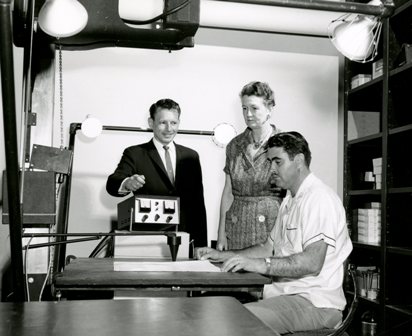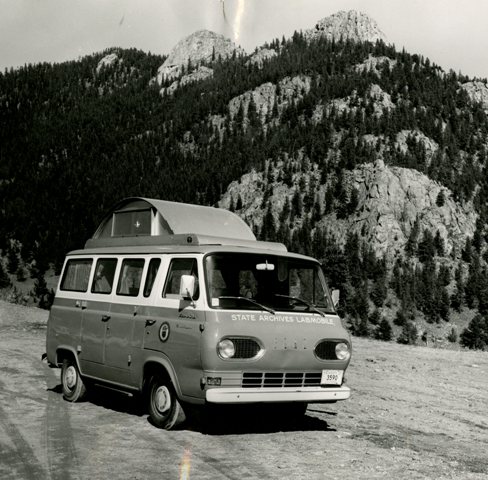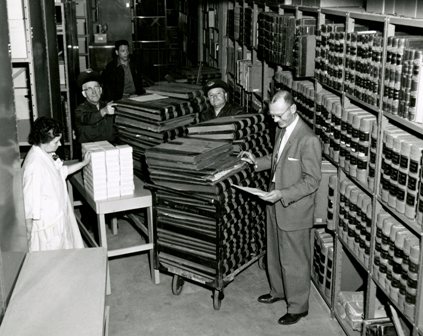About Us
Mission Statement, Services, and Functions

Colorado State Archives mission is safeguarding the administrative and documentary history of Colorado by managing, collecting, preserving, and providing access to state and local government records.
Records management, archives management and micrographics quality control are administrative functions provided to state and local government agencies in Colorado to ensure the preservation of Colorado's permanent legal and historical records. Information and research functions provide for citizen access to public records created by the legislative, executive and judicial branches of state government.
The Colorado State Archives is the legal repository for selected historical and contemporary records and information generated by state and local governments in Colorado. The National Association of Government Archives and Records Administration and the Council of State Governments have said that "state archives are the guardians of much of a state's public documentary heritage, resources essential in establishing a citizen's rights, understanding his past, coping with his present, and planning for his future. The value of a state archive stems from the information it contains and the evidence it provides. Its records are essential to administrative and cultural continuity."
Records Management/Records Disaster Recovery/Records Destruction Services
Employees from state and local government agencies can request assistance with records retention and disposition scheduling. By statute, the State Archives sets legal retention periods and disposition requirements for records created by over 240 state agencies, offices of the 64 counties, 280 municipalities, 176 school districts and 1400 special districts. The State Archives advises when and how public records may be transferred, destroyed or if they must be kept permanently. In addition, the State Archives can provide guidance in the recovery of damage to records from disasters. Please see our Records Management page for detailed information.
Micrographics/Optical Imaging and Disaster Recovery Services

Any agency of state or local government that microfilms or images its records may store the original at the State Archives for back-up or disaster recovery purposes at no cost. Guidelines on micrographics quality and optical imaging are available from our office.
Records Transfer and Storage Services
The State Archives serves as the legal repository for permanent records generated by state agencies. Records are transferred from state agencies in accordance with agency records retention schedules. Some records from local governments may be accepted for permanent storage on a very selective basis.
Research and Reference Services
The Colorado State Archives has a wealth of information for research and reference. We receive additional accessions periodically. We will respond to mail and phone requests but suggest that you conduct any extensive research at our facility whenever possible because of the voluminous nature of our collections. Records deposited at the Colorado State Archives are available for use subject to restrictions or limitations imposed by law, by executive order, by the agency from which they have been transferred, or by the State Archivist. The research and reference functions are cash funded activities of state government, hence fees for service apply. Please see Colorado Laws Concerning Public Records for more information about fees. The staff will assist researchers in identifying records that will assist them with their information needs and will retrieve records requested by researchers. Many original records may also be available for viewing in micrographic formats. Records must be used in the Research Room because they may be the only or definitive copy, and may not be withdrawn from the State Archives. There is also a pull limit of 10 boxes or record items during your visit, so please plan accordingly. The staff will make copies of records upon request. Please see our Public Records page for further descriptions of the records we have.
History of the Colorado State Archives

In 1943, the Colorado legislature created the position of State Archivist to oversee the retention and disposition of public records. The first State Archivist, Herbert O. Brayer, filled the office as a staff member of the Colorado State Historical Society. Dolores C. Renze, one of three women to hold such a position at the time, succeeded to the office in 1949, retaining the position until 1973. During her tenure, the State Archives and the Public Records became a division within the Historical Society. In 1959, the State Archives became independent of the Society. George E. Warren became State Archivist in 1974 and retired in 1987. Terry Ketelsen worked for the state for over 40 years and retired as State Archivist in 2012. George Orlowski became State Archivist in 2012 and retired in June 2016. Aly Jabrocki, current State Archivist, took the reign in November 2016.
The State Archives has been housed in four different state buildings during these years, including the old Woodward mansion at 1530 Sherman Street. Records were housed in tunnels under the capitol complex and in rented storage space in nearby buildings before its move into the Centennial building in 1976, where the State Archives now occupies the three lower floors. The State Archives also stores records in a satellite storage facility southeast of Denver near Simla, and a northern facility in Thornton, Colorado.